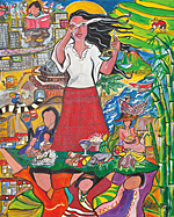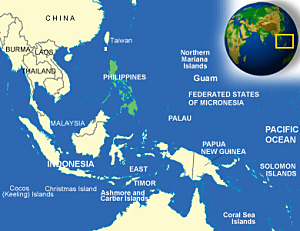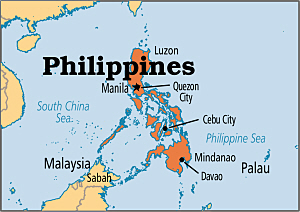World Day of
Prayer is an international, ecumenical, prayer movement initiated and
carried out by Christian women in more than 180 countries and over 1000
languages. Every year Christians of many traditions and all
ages,celebrate a common day of prayer on the first Friday in March.
 A
Glimpse of the Philippine Situation A
Glimpse of the Philippine Situation
Artist Rowena
“Apol” Laxamana-Sta.Rosa.
World
Day of Prayer services are held all around the world, beginning in
Tonga and New Zealand in the east and continuing throughout the day to
Samoa and Alaska in the west. It bring the needs of the world, and of
the writing country in particular, before Almighty God knowing that He
will hear and answer us, as we pray in the name of Jesus Christ, our
Lord and Saviour.
God invites us to have a
prayer relationship with Himself, but He also expects us to have
concerned relationships with our neighbours, throughout the world.
Prayer must be
accompanied by action, as God moves our hearts and directs our thoughts.
Penicuik met in
St.James the Less at 7.30pm
|
| | | World Day of Prayer - 3 March 2017 |

On
Friday 3 March at 7.30pm a service to
celebrate the Women’s World Day of Prayer was held in St James the Less church. The theme for 2017 was ‘Am I being unfair to you?’
Setting the scene.
 The Philippines comprises a group of islands located on the Pacific Ring of Fire close to the equator. Approximately
1,000 of its islands are populated, and less than one-half of these are
larger than 2.5 square kilometers (1 sq mi). Eleven islands make up 95
percent of the Philippine landmass. The Philippines comprises a group of islands located on the Pacific Ring of Fire close to the equator. Approximately
1,000 of its islands are populated, and less than one-half of these are
larger than 2.5 square kilometers (1 sq mi). Eleven islands make up 95
percent of the Philippine landmass.
The islands, being located on the
Pacific Ring of Fire and close to the equator, make the Philippines
prone to earthquakes and typhoons, with an average of twenty typhoons
annually.

The last decade has seen an increase in severe typhoons,
notably Yolanda (international name Haiyan). Yolanda made landfall in
the central Philippines in November 8th, 2013, as a category five
super-typhoon. It is the most severe storm to hit landfall ever
recorded, which claimed thousands of lives.
Women
Before
Spanish colonisation in the 16th century, women occupied some status in
the community. However, the Spanish introduced feudalism, leading to
the subordination of women throughout the archipelago.
Today
many Filipino women take on the role of breadwinner, often working
abroad as service crew, domestic helpers or skilful professionals in
the medical field.
The Philippine Constitution provides for
equal rights, yet in practice Filipino women are often discriminated
against and treated as subordinates in the home, in the church and in
society.
Politics
The
Philippines is a constitutional republic with a democratic government
led by the President . However, the predominantly Muslim island of
Mindanao has its own autonomous regional government.
17% of
elected government posts are filled by women.There have been two women
presidents – Corazon Aquino and Gloria Arroyo, both of whom come
from families with a long political tradition.
| |